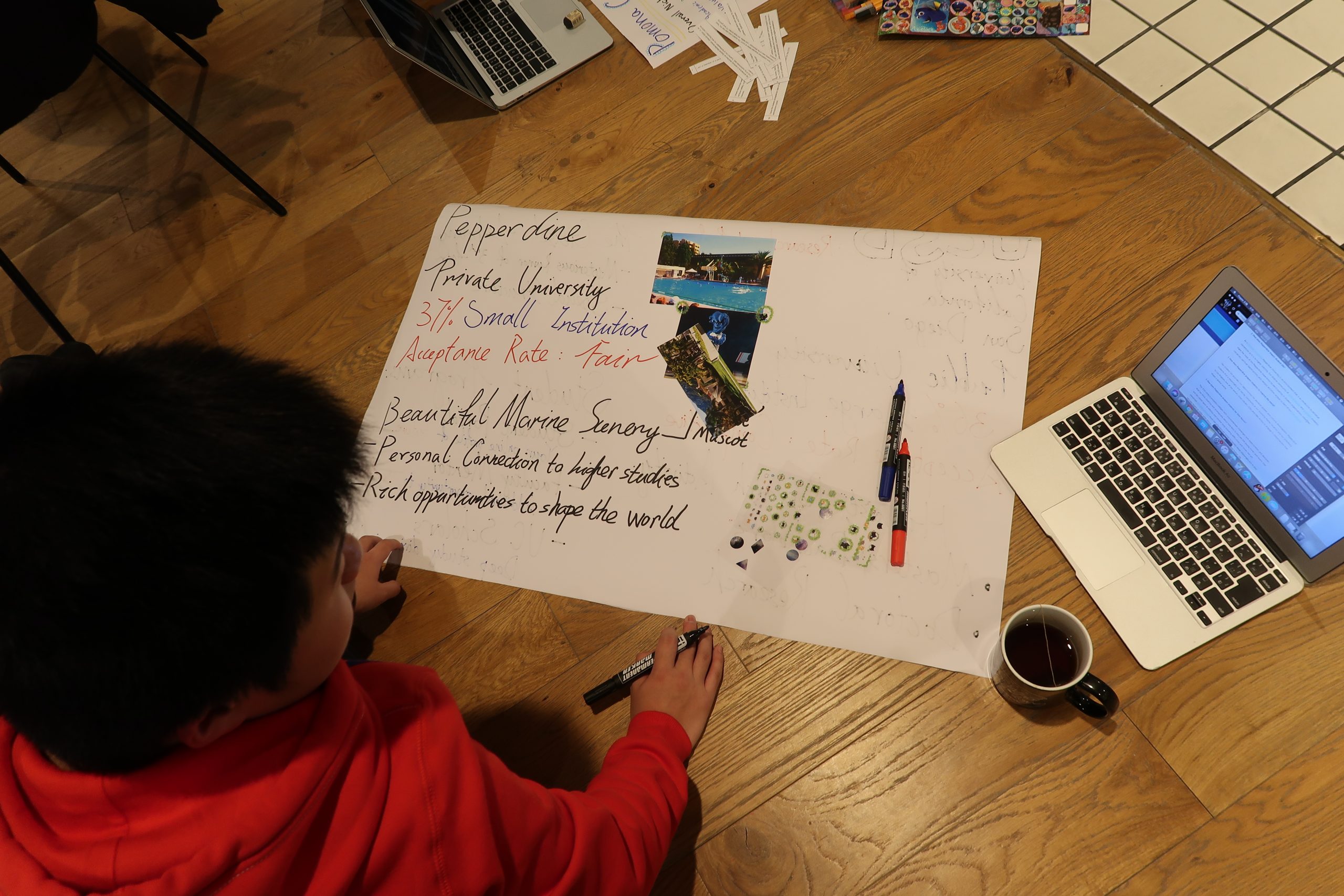

US Counselor Updates: Curriculums and Class Selection
Our team of experts offers you advice on how to select your classes.
Why take Advanced Placement (AP) Classes?
by Andy
Andy Yang
- B.A. of Economics, California State University, Berkeley
- 5 years of study abroad consulting experience helping students apply for undergraduate, graduate and doctorate programs
- Founder and president of College Start-up incubator with chapters in Stanford, UCB, and UCLA
Taking the AP curriculum is a good way to demonstrate college readiness, which can impress admissions officers during the application process.
High scores on AP exams will reward students with college credits, which will allow students to graduate sooner, pay less tuition, and increase general flexibility for future scheduling and course selection.
Accomplishment in AP coursework may also increase students’ chances for college-specific merit financial aid*.
* Primarily applicable for domestic US students only
How do we go about choosing AP Classes?
As an Ivy League aspirant, a student should be expected to take 4~6 courses over the course of their high school career. To become a competitive candidate for Top 30 schools, 2~4 APs with a strong student profile is expected.
For selecting specific course topics, a student should choose their strong subjects and ones that relate to their interests. For AP exam options and statistics, check out the following charts:
| Exam Name | # of Students Taking 2019 |
| English Language and Composition | 573,171 |
| United States History | 496,573 |
| English Literature and Composition | 380,136 |
| Gov. And Politics – US | 314,825 |
| World History | 313,317 |
| Psychology | 311,215 |
| Calculus AB | 300,659 |
| Biology | 260,816 |
| Human Geography | 225,235 |
| Statistics | 219,392 |
| Spanish Language and Culture | 187,133 |
| Environmental Science | 172,456 |
| Physics 1 | 161,071 |
| Chemistry | 158,847 |
| Macroeconomics | 146,091 |
| Calculus BC | 139,195 |
| European History | 100,655 |
| Computer Science Principles | 96,105 |
| Microeconomics | 91,551 |
| Computer Science A | 69,685 |
| Physics C: Mechanics | 57,131 |
| Seminar | 43,441 |
| Studio Art: 2-D Design | 37,749 |
| Spanish Literature | 29,345 |
| Physics C: Electricity & Magnetism | 25,342 |
| Art History | 24,476 |
| Physics 2 | 23,802 |
| Gov, and Politics – Comparative | 23,533 |
| French Language and Culture | 23,249 |
| Studio Art: Drawing | 21,769 |
| Music Theory | 18,864 |
| Research | 15,724 |
| Chinese Language and Culture | 13,853 |
| Latin | 6,083 |
| Studio Art: 3-D Design | 6,040 |
| German Language and Culture | 5,160 |
| Italian Language and Culture | 2,658 |
| Japanese Language and Culture | 2,479 |
| Total Number of AP Exams Taken | 5,098,815 |
| Total Number of Students Taking AP Exams | 2,825,710 |
| Exam Name | Passing Rate (3+) | Passing Rate (5) |
| Studio Art: Drawing | 91.1% | 20.8% |
| Chinese Language (Total) | 89.9% | 60.1% |
| Spanish Language (Total) | 88.7% | 25.2% |
| Studio Art: 2-D Design | 86.4% | 21.0% |
| Calculus BC (AB Subscore) | 86.2% | 49.5% |
| Spanish Language (Standard) | 82.4% | 15.2% |
| Physics C: Mechanics | 81.8% | 37.7% |
| Seminar | 81.1% | 7.1% |
| Calculus BC | 81.0% | 43.0% |
| Japanese Language (Total) | 79.3% | 45.3% |
| French Language (Total) | 77.1% | 16.1% |
| Research | 75.9% | 10.7% |
| French Language (Standard) | 73.9% | 10.1% |
| Physics C: Electricity & Magnetism | 73.0% | 37.6% |
| German Language (Total) | 72.3% | 21.0% |
| Spanish Literature | 72.3% | 9.5% |
| Computer Science Principles | 71.9% | 13.8% |
| Studio Art: 3-D Design | 70.0% | 10.0% |
| Microeconomics | 69.6% | 24.3% |
| Computer Science A | 69.6% | 26.7% |
| Chinese Language (Standard) | 66.8% | 16.3% |
| Italian Language (Total) | 66.1% | 13.6% |
| Gov. And Politics – Comparative | 66.0% | 22.4% |
| Physics 2 | 65.4% | 14.2% |
| German Language (Standard) | 65.1% | 8.7% |
| Biology | 64.7% | 7.2% |
| Psychology | 64.5% | 20.5% |
| Music Theory (Nonaural) | 64.1% | 20.3% |
| Music Theory | 63.7% | 21.2% |
| Music Theory (Aural) | 63.4% | 21.5% |
| Art History | 63.1% | 11.9% |
| Latin | 62.9% | 13.0% |
| Japanese Language (Standard) | 62.4% | 15.5% |
| Italian Language (Standard) | 62.0% | 5.8% |
| Statistics | 59.7% | 14.7% |
| Macroeconomics | 58.9% | 19.1% |
| Calculus AB | 58.4% | 19.1% |
| European History | 58.1% | 11.7% |
| Chemistry | 55.6% | 11.5% |
| World History | 55.3% | 8.6% |
| Gov. And Politics United States | 55.1% | 12.9% |
| English Language and Composition | 54.3% | 9.9% |
| United States History | 53.7% | 11.8% |
| English Literature and Composition | 49.7% | 6.2% |
| Environmental Science | 49.2% | 9.4% |
| Human Geography | 49.1% | 10.8% |
| Physics 1 | 45.4% | 6.7% |
AP Central
Why take International Baccalaureate (IB) classes?
By Hui Qin
Hui Qin
- Former Arts Peer Mentor at The University of Melbourne
- Former Global Officer at Monash University’s Study Abroad Department
- Ranked in the top 10 percent of IB grades globally upon finishing high school
- Visual Artist for MudFest (Melbourne University’s Art Festival) in 2017
- Featured visual artist in Antithesis Journal Volume 27 and Farrago Magazine Edition 5 in 2017
- Intern at Shanghai Daily and at F&T group
- Multicultural upbringing with living abroad experience in five countries to date
Oh IB (the diploma program), you either hate it or love it while going through it…and you’ll be thankful for it in your fresh year of college (IB alumni, you know what I mean. IB students, you will find out soon).
I’m not going to spend too much word count writing about what the IB system is here, as IB does that pretty well on their website!

The basics of the curriculum are as follows:
- Pick 3 subjects at a higher level, 3 at standard level. Scored on a scale from 1 – 7.
- Extended Essay (EE) – an independent, self-directed piece of research, finishing with a 4,000-word paper. Scored alongside TOK, see matrix below.
- Theory of Knowledge (TOK) – students reflect on the nature of knowledge and on how we know what we claim to know. Scored alongside EE, see the matrix below.

- Creativity, Action, Service (CAS)- students complete a project related to those three concepts. Ask your IB CAS coordinator for the specific activities and number of reflections required for you to complete CAS – every school has their own requirements. Remember, even if you get a 45/45 in IB, you won’t get the diploma if you do not meet CAS requirements!!

How IB scores are evaluated are dependent on the college and the major applied to. Please speak to your counselor as to which IB subjects are best suited for you.
As a general rule of thumb:
The latest IB world average score, from November 2019 exams, is 28 (out of 45).
33 is decent but not likely to get you into highly selective colleges. This is like a B student.
36–39 is quite solid and you should have a lot of options. This is like an A- student.
40 is the lower end of the elite scale (for example, 40 is on the lower end of students who are getting offers at Cambridge University) and makes one a stronger candidate for highly selective colleges. This is like an A to A+ student.
IB is more project-based in comparison to APs and A-levels. The number of subjects studied and extra 3 components (EE, TOK, CAS) to be completed would require a student to be able to balance their time extremely well between academic studies and extracurricular activities (a necessary condition of high school graduation, mandated by CAS). It may also be more suitable for students who do not want to “grind” for tests, but instead prefer to have the time to analyze and write for project-based assignments instead. Please speak to your counselor as to which curriculum is most suitable for you.
Why take Advanced Level (A Level) Classes?
By Suzanna Brown
Suzanna Brown
- Endowment Award and Foreign Language Area Studies, Center for Chinese Studies (CCS)
- (FLAS) Fellowship for a Master’s Degree, University of Michigan
- Accepted to the Inter-University Program (IUP), Tsinghua University in Beijing, China
- Liberal Arts honors graduate, Calvin College, number one ranked regional college in the Midwest
- Former English Teacher, Northeastern University, Qinhuangdao in Hebei, China
- Former Administrative Assistant, Grand Rapids Christian High School International Student Program
- About GCSE
Pupils in both pre-A Level and pre-IB schools typically take GCSE examinations (General Certificates of Secondary Education). These are the final exams for compulsory education in a school. They are taken at 16 years old, the end of Year 11 (or Grade 10). Students usually take GCSEs in about eight to ten subjects, which must include English and Mathematics, and should include the following:
- English
- mathematics
- history or geography
- the sciences
- a second language
After GCSEs students can progress to Advanced Level courses (AS level and A Level) and exams. GCSE and Advanced Level qualifications are set by examination boards. AQA/OCR/Edexcel/WJEC/CCEA are the exam boards for GCSE and A Level. They set their own courses and exams which tend to differ slightly from each other. Schools can choose which board’s courses they offer.
GCSEs matter as much as other types of 9th and 10th grade scores for students. The grades and exams are important, as they are included in the GPA and on Transcripts.
- About A-Level
The General Certificate of Education Advanced Level, or A Level, is the ‘gold standard’ of Cambridge qualifications. It is accepted as an entry qualification by universities of the UK, the European Union, and elsewhere around the world.
A Level examinations are usually taken after 13 years of education and are based on approximately 360 hours of guided learning per subject, normally over a two year period. A Levels are highly specialized and a student will normally take three subjects, although occasionally exceptional students take four or five.
Most students planning to go on to Higher Education study for ‘AS Levels’ (Advanced Subsidiary) and ‘A Levels’, (Advanced Level) at the age of 16 to 18 or 19. They can choose from a very wide range of subjects to suit their interests and strengths. ‘AS’ level exams are taken after 1 year of study. ‘A Levels’ require students to take an exam after a two-year course and are harder than AS Levels. Students wishing to apply for university typically take 3 or 4 A Level subjects.
A Levels are considered equivalent to AP and IB HL courses, even though actual class rigor varies.
- Test Grade
There are six passing grades (A* – E). Typical UK university entrance requirements are above three passes at grade C for academic courses in established universities. Very popular courses will often require higher grades. Good A Level grades can also be a key to admission for all the world’s major universities. Similar to the IB curriculum, the examining body sends final examination results to colleges after students have accepted admission to US and UK schools. Universities are typically looking at AS Level grades when deciding on an offer of admission.
Example:
Academic Qualification requirements
- A-level: A*AA (Mathematics grade A* required, plus grade A in Economics if offered.)
- IB: 39 points (A score of 19 points in three higher level subjects including grade 7 in Mathematics and grade 6 in Economics if offered with no score lower than 5.)
- Subjects
The subject content of each of the A Level syllabuses has been subdivided into two parts: the AS syllabus content which is expected to be covered in the first half of the course, and part two of the syllabus commonly referred to as ‘A2’.
This flexible approach enables students to choose from three options:
-
- Take all A Level components in the same examination session at the end of a course of study, usually at the end of the second year (Year 13 or Grade 12)
- Follow a staged assessment to an A Level by taking the AS qualification in one examination session, and the A2 assessment in a subsequent session
- Take the AS qualification only – either at the end of a one-year or two-year course.
Note: The A2 examination cannot be taken as a standalone qualification.
AS Level may be taken as a freestanding qualification and are accepted in all UK universities. They carry half the weight of an A Level so, for example, students may be admitted with suitable grades in two A Levels and two AS Levels.
-
- Majority of Subjects:
| Accounting
Anthropology Arabic Archaeology Art and Design Biology Business Studies Chemistry Chinese (Mandarin) Citizenship Classical Civilisation Computing Creative Writing Critical Thinking Dance Drama (and Theatre Studies) Design & Technology Economics Electronics English Language English Literature Environmental Studies/Technology Film Studies French |
General Studies
Geography Geology German Government and Politics Health and Social Care History History of Art (and Design) Latin Law Mathematics Media Studies Music Philosophy Physical Education Physics Religious Studies Sociology Sports Science Statistics World Development |
Recommended Article: UCAS Undergraduate: what to study
It is recommended to research universities and their course requirements by going directly to the university website and reading through the course information. This will provide students with detailed information not only of qualification requirements, such as academics and English but also offers more detail about the course offering itself which can give students a better idea of what the program is.
References:
https://www.ucas.com/undergraduate/what-and-where-study/ucas-undergraduate-what-study
https://www.theuniguide.co.uk/advice/ucas-application/the-real-story-behind-entry-requirements
Follow us on WeChat





